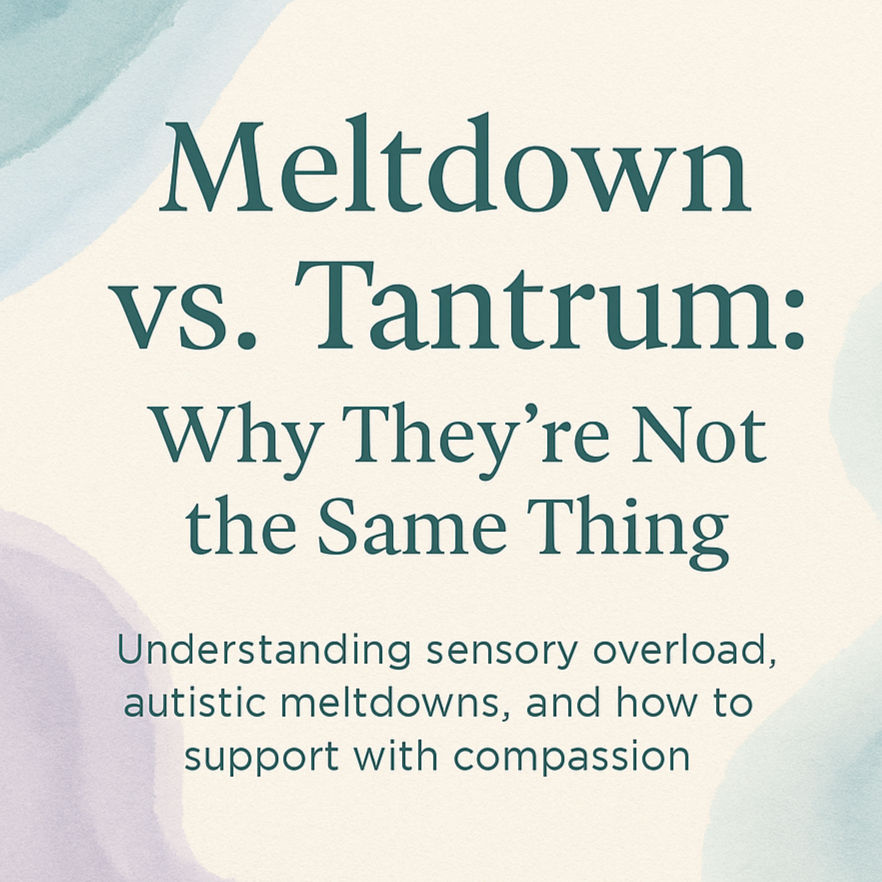Meltdown vs. Tantrum: Why They’re Not the Same Thing
- Alissa Merklinger

- Jun 14
- 4 min read
This is something really important that I want to talk about.

I see so many people—teachers, parents, strangers in Target—refer to children or adults having a meltdown as “throwing a tantrum.” And to the outside world, I get it. They might look similar.
So today, let’s talk about the difference. What causes a meltdown, what makes it different from a tantrum, and how you can support someone through it.
(Spoiler alert: Discipline is not the answer.)
But anyway...
First, What Is a Tantrum?
A tantrum is usually what happens when someone—often a child—is emotionally overwhelmed or seeking a specific outcome.
They want something.They were told no.They’re trying to get a response.
Tantrums can include:
Crying, screaming, yelling
Hitting, hiding, falling to the floor
Running away or acting out in frustration
And yeah, they can be intense. But they’re usually goal-driven. The person is trying to get something (a toy, a snack, to stay at the park, etc.) or express frustration at not getting their way.
Once they calm down, there’s often space for reflection, conversation, or rest. Sometimes it ends in a time-out or a break to reset.
Temper Tantrum
A Goal-Oriented Reaction
A tantrum happens when someone (usually a child) wants something and isn’t getting it (more TV or tablet time, a snack, something in a store, etc.).
It is a response to frustration, often in an attempt to gain control (like getting a toy, staying up late, or avoiding something unpleasant).
A tantrum usually stops when the person gets what they want or realizes it won’t work.
The person is often still aware of their surroundings and may even pause mid-tantrum if distracted.
A tantrum is about control.
So, What’s a Meltdown?
Here’s the part people miss: a meltdown can look very similar on the outside—but the cause is completely different.
Meltdowns are triggered by sensory overload and distress, not a desire for attention or to manipulate a situation.
When an autistic person is having a meltdown, it can include all the same things—screaming, crying, running, hiding, hitting, etc.—but it’s not about control. It’s about overwhelm.
Sensory Overwhelm & Meltdown
A Loss of Control
A meltdown happens when the brain is overwhelmed by too much sensory input (lights, sounds, textures, emotions, etc.).
It is not a choice and cannot be stopped by giving in to demands—it’s a nervous system response to overload.
The person may become unable to communicate, self-regulate, or even recognize what’s happening around them.
Meltdowns can look like crying, yelling, or shutting down completely (going nonverbal, covering ears, freezing).
They usually last until the nervous system can reset, which may require quiet time, sensory tools, or a safe space.
A meltdown is about overload.
Warning Signs (aka: Help Us Before the Meltdown Hits)
Meltdowns don’t always happen out of nowhere. There are usually signs leading up to it. And if you know what to look for, you can help someone exit a situation before the meltdown happens.
Here are a few common signs:
Asking to leave or go home
Lagging behind or moving more slowly
Increased stimming (rocking, pacing, fidgeting)
Covering ears, avoiding eye contact
Flushed skin or zoning out
Seeming distracted, irritated, or disconnected
If these signs are ignored—or if the person is forced to stay in the overwhelming environment—a meltdown can be the result.
What a Meltdown Feels Like (From the Inside)
Meltdowns are not dramatic. They’re not attention-seeking. They are a full-body, full-brain shutdown from overstimulation. They’re exhausting. They can last longer than a tantrum. And no, telling us to “calm down” doesn’t help. I’m 32 years old and still have meltdowns weekly.
Everyone’s experience is different, but here’s what it feels like for me:
The world around me starts to shrink. Sounds get louder. Movements blur. Breathing feels harder. It’s like I’m in a fishbowl and everything outside is echoing. My brain starts yelling at me:
“You’re overreacting.”
“You’re embarrassing yourself.”
“Alissa, STOP IT.”
These thoughts slam into my head like neon signs. I can’t focus. Everything feels shaky under my skin—especially in my arms. I rock, shake, hyperventilate, cry. I lose track of what’s around me.
If I’m lucky, I find a bathroom or my car. But sometimes I can’t. And if people are nearby? It makes it so much worse. Because then I’m not just overwhelmed—I’m ashamed.
“If I know I’m overreacting, imagine what they must think.”
It spirals quickly.
How to Help Someone Having a Meltdown
You usually can’t stop a meltdown. But you can support someone through it. The best thing? Ask them ahead of time what helps. (Not during. Not in the middle of one. Later. Gently.)
If it’s your child, a friend, a partner, a coworker—having a plan makes a huge difference.
Here are some suggestions:
Give them space and quiet.
Use yes/no questions if you need to talk. (Not “What’s wrong?”)
Offer a drink. Hydration helps more than people think.
Ask if they want to step outside or go somewhere quieter.
Find their fidgets or sensory tools, if they have them.
Don’t draw attention. We don’t need an audience.
Give them more time than you think they’ll need. We’re not okay just because we stopped crying.
Final Thoughts
Meltdowns aren’t childish. They’re not bad behavior. They’re a sign that someone’s nervous system is overwhelmed and needs support.
Every person is different. What helps one person might overwhelm another. But the more we talk about this stuff, the more understanding and compassion we can build.
If you’ve got tips or experiences to share, drop them in the comments—I’d love to hear them.
Stay safe, stay stimmy,
Alissa



Comments